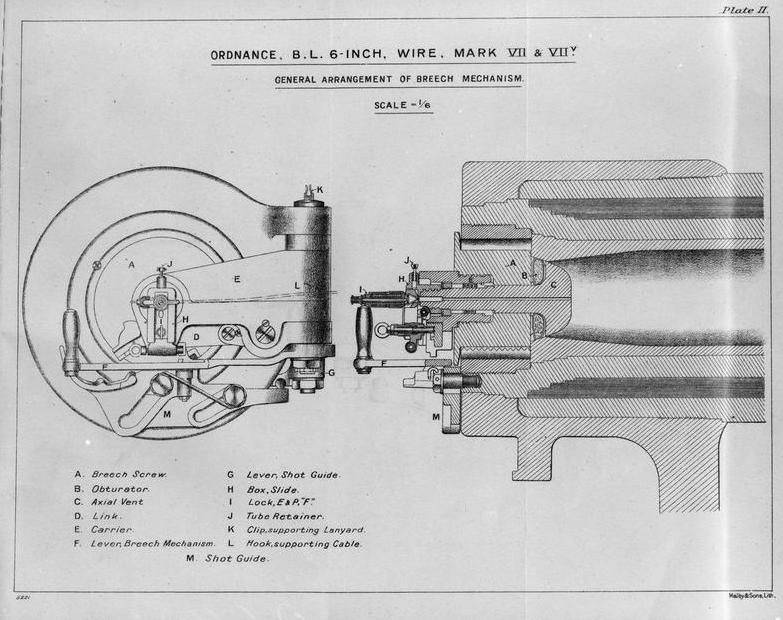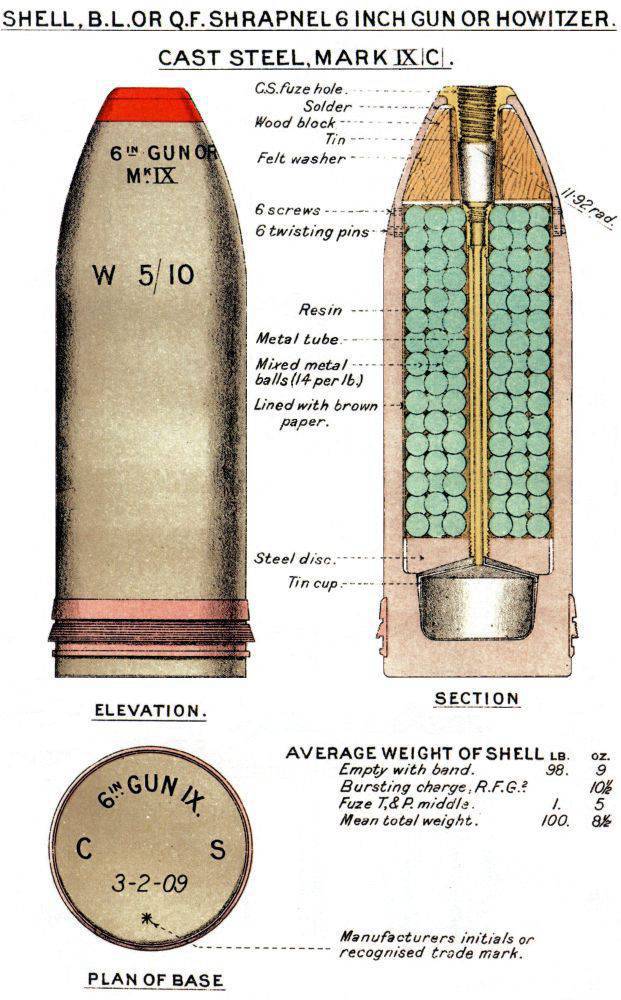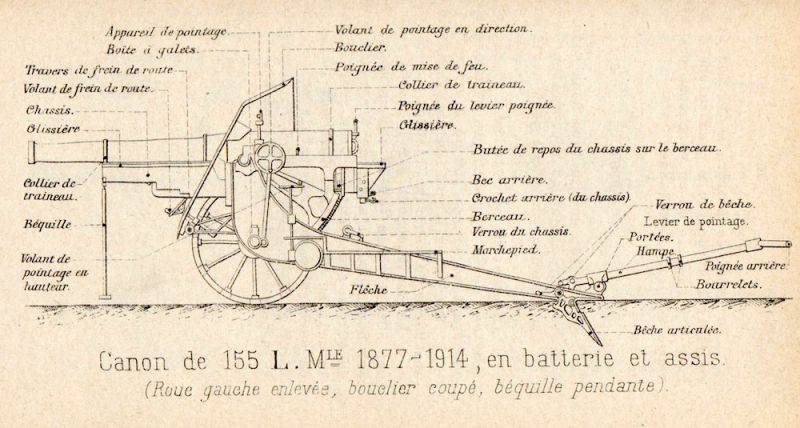Fateful six inches (part of 1)
In the army of the Austro-Hungarian Empire, the caliber 150-mm was adopted and, accordingly, the M.XNXX / 14 howitzer developed by Skoda was adopted. Moreover, her real caliber was even smaller - 16-mm, but it was designated as 149-cm, as well as the field gun, which had an 15-mm caliber, but was designated as 7,65-cm. The gun weighed 8 t, had a declination angle 2,76 and elevations 5 °, and could shoot with a 70 kg projectile at a distance of 42 km, i.e., further 7,9-mm field guns and, therefore, suppress their batteries from afar. The device device was traditional: single-bar carriage, recoil devices mounted under the barrel, splinter shield, wooden wheels on the spokes.
For the destruction of vertical obstacles and counterbattering, Skoda in 1914 developed the 150-mm M. 15 / 16 cannon, replacing the old M. 1888 cannon. However, it began to be tested only in 1915 year, and entered the front even later. It turned out to be a cumbersome, but impressive tool, called the “autocannon,” especially to emphasize that it had to be transported solely by a motorized burden.
At the same time, it had a serious drawback: when transporting it over long distances, it was necessary to disassemble it into two parts, as, indeed, the M.14 / 16 howitzer. Its projectile was heavier than a howitzer - 56 kg, its flight speed was 700 m / s, and the range - 16 km. Then the gun was improved (after the release of the first 28 ind.) By increasing the angle of elevation of the trunk from 30 ° to 45 °, as a result of which the distance increased to 21 km. However, the rate of fire was low: only one shot per minute. In addition, due to the fact that the barrel moved along the axis of the wheels when hovering, the horizon was induced only by 6 ° in both directions, and then it was necessary to move the tool itself. The latter, however, was a very difficult affair, as this 11,9 gun weighed tons. Here on it the real caliber was already 152 mm.
After the First World War, these guns appeared in Italy as war reparations and were used in the course of military operations in Albania, Greece and North Africa. Under the designation 15.2 cm K 410 (i) they were also used in the artillery units of the Wehrmacht.
Britain was preoccupied with the adoption of new 152-mm howitzers (BL 6inch 30cwt Howitzer), equipped with a rifle brake that was one of the first to be rolled back in 1896, so they could even take part in the Anglo-Boer War. This 3570 kg gun weighed in and had a roll-up hydraulic spring compensator. The maximum elevation angle of the barrel was only 35 °, which, together with the short barrel, gave a low projectile speed (total 237 m / s) and a range in 4755 m. The weight of the projectile filled with liddite was 55,59 kg. Shrapnel had a weight of 45,36 kg.
Soon, the elevation angle of the trunk was increased to 70 °, which is why the range increased to 6400 m, which, however, was not enough even in the First World War. In the post-war years, it was in service with the army of Greece, but the obsolescence of its design was obvious, although it was used in its battles. However, exactly until the English had 152-mm howitzers 6inch 26cwt, which turned out to be much more modern and successful. Create it began in the year 1915, and at the end of this year, she entered into service.
A new howitzer weighing 1320 kg has become the standard gun of this caliber in England, all of which were released 3,633. She had a simple hydropneumatic recoil brake, had a shelling sector in 4 °, and the angle of elevation was 35 °. The 45-kg shrapnel projectile had an 8,7 km reach, but then a lightweight projectile was adopted in the 39 kg, the range with which increased to 10,4 km. The gun was massively used in battles on the Somme River in 1916. The howitzer was also used in the British Army (until the end of the war 1,246 guns) and was supplied to numerous allies, in particular, the Italians. She also visited Russia. They were not supplied to the tsarist government, but the White Guards received them and, apparently, something of this amount was then red. The guns of this type released 22,4 million shells and this is a kind of record. Then, during the Second World War, this howitzer was put on pneumatic tires with developed lugs, and as such it ended its participation in wars, fighting both in Europe and in Africa, and even in distant Burma.
It is clear that if the army has a 152 mm howitzer, then God himself ordered to have a gun of the same caliber for flat shooting. The BL 6-inch Gun Mark VII was such an instrument in the British army. In fact, it was a ship cannon — such as those installed on armadillos and cruisers — mounted on a wheel drive designed by Admiral Percy Scott with minimal rework. They began to test them in the years of the Anglo-Boer War, where they had a good account of themselves, and after the war, further improvement of its design was continued. This unification turned out to be successful, since the same gun now entered the fleet, coastal defenses and ground forces. However, the gun came out heavy. Only its trunk weighed 7,517 kg. The shell weighed 45,4 kg. Moreover, its speed depending on the charge ranged from 784 m / s to 846 m / s, respectively. The total weight of the system was 25 tons, and the firing range was about 11 km at an elevation angle of 22 °. Then this angle was increased to 35 ° and the range, respectively, increased. The disadvantages of the gun, in addition to the large weight can be attributed to the fact that the recoil devices on it were completely absent, and it rolled away after the shot. We had to arrange special ramps for wheels - an anachronism of the XIX century - and install them before shooting. However, in the coastal defense of England, these guns served until the 50-s of the last century.
It was probably inconvenient for the British to use such an anachronism (although this gun proved itself in combat conditions), because they created its improved model BL 6-inch Gun Mark XIX. The new tool was lighter (10338 kg), more mobile, had reach (at an elevation angle of 48 °) 17140 m and also had a recoil mechanism. Another important feature was the unification of the gun carriage of this gun with the gun 203-mm howitzers.
As for France, the First World War hardly started, as the losses in the 75-mm guns turned out to be so significant that in the army they began to use everything that could shoot. These are the 155-mm guns of the 1877 model of the year - the famous "Long Thom", now and then mentioned in the novel "Captain Sorvi-Head" by Louis Bussenard, and also more modern types of guns of the same caliber. The first among them was the 1913-mm Mle 155 / 1877 cannon developed in 1914, which had an old barrel, but equipped with a hydraulic recoil brake and a pneumatic tensioner. The wheels on the carriage remained wooden, which is why the transportation speed did not exceed 5-6 km / h. The weight of the gun was 6018 kg, the declination and elevation angles were from -5 ° to + 42 °, and the firing range was 13,600 m. The gun made 3 rounds per minute, which was an excellent indicator for such a caliber. Shells used a variety of weights from 40 to 43 kg, and high-explosive and shrapnel (416 bullets). This weapon was used - it turned out to be so good even during the Second World War, in particular on the “Maginot Line”. Being captured by the Germans, these guns were used in the German army under the designation15.5cm Kanone 422 (f).
The next in the French park 155-mm guns is Mle 1904 - a rapid-fire gun designed by Colonel Rimallo. Outwardly, it was a typical instrument of that time, with a single-bar carriage, a hydropneumatic recoil brake under the barrel and wooden wheels. But he had his own “zest” - a shutter that automatically opened after a shot and also automatically closed. A well-trained crew could fire 42,9-kg grenades with a rate of 15 rounds per minute - a kind of record of speed for such a weapon. In addition, for such a caliber it was quite light - 3,2 t, only its firing range was small - only 6000 m, which was not bad in 1914, but it became impossible in 1915.
Directly on the eve of World War I, there were two firms in France that produced 152 / 155-mm both for export and for their own needs - Schneider and Saint-Chamond. So, Schneider developed the 152-mm howitzer for Russia, and it was she who became the only weapon of this caliber (in two versions - the serf 1909 and the field 1910) the only weapon of this caliber in Russia during the First World War.
Meanwhile, after analyzing the course of the fighting on the Western Front in 1915, General Joffre, commander of the French troops, considered Rimallo's guns inoperative and demanded to urgently create a new rapid-fire howitzer of 155 mm caliber.
Saint-Chamond promised to execute an order for 400 guns at the rate of 40 gun production per month by the fall of 1916. Schneider also took part in this competition, but lost. Saint-Chamon has made his sample faster, and besides, the range of his howitzer was 12 km, which, however, did not prevent him from doing all the same Schneider howitzers - more familiar, lighter and longer-range. Unusual, for example, was a semi-automatic vertical wedge bolt, whereas all other French implements had piston bolts. The muzzle flame and the shock wave were very strong when fired, from which (more than from bullets and shrapnel) his calculation was protected by a gun shield. The weight of the gun was 2860 kg. Tools of this type were supplied to Romania, as well as Serbia in 1917-1918.
However, the Schneider company produced not only howitzers, but also 155-mm guns of the Mle 1918 model. It used the 1877 stem of the Bandja construction, superimposed on the howl howitzer carriage of the 1917 sample of the year Mle 1917. The first 4 howitzers entered the army before November 1918 of the year, and later 120 units were released. The weight of the gun was 5030 kg, and the range at the maximum elevation angle in 43 ° was 13600 m. The rate of fire was 2 shot per minute.
The Germans also got these guns and were in service with the Wehrmacht under the designation 15,5cm K 425 (f).
It is interesting that, perhaps, only the French during the years of the First World War created such a large number of 155-mm guns, both guns and howitzers. However, the most modern way in this arsenal is Canon de 155 long GPF or “special power tool” designed by Colonel Louis Fiyu. It was distinguished by a long barrel and sliding beds for the first time appearing on such a weapon, which made it possible to maneuver fire in a sector equal to 60 °, with a maximum elevation angle of 35 °. With the weight of the 13 gun and the firing range for it at that time was simply impressive - 19500 m!
In total, France received 450 of such guns, and their use began in Flanders. Subsequently, it was produced in the United States, in addition, Poland received a certain amount of these guns, and the Germans used them on the fortifications of their famous Atlantic Wall.

Mk.VII howitzer, Bange system shutter, with mushroom sealant

Six-inch English shrapnel shell

Information